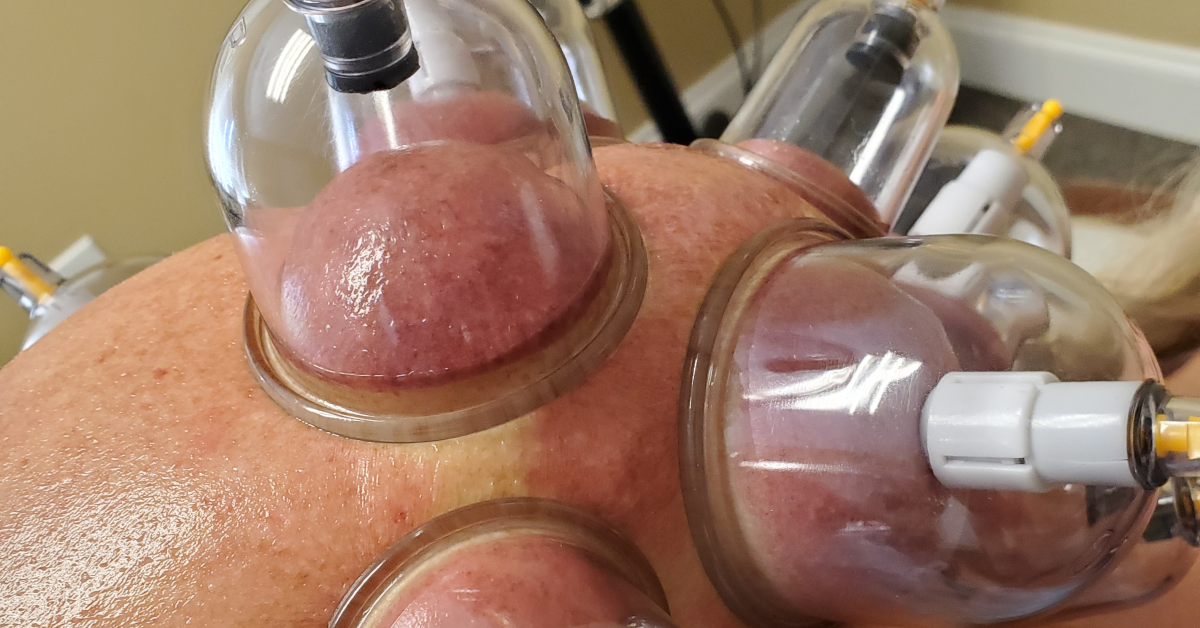How Cupping Can Help You Overcome Pain and Injury
If you watched the 2016 Olympics, there was a lot of talk around Michael Phelps and the dark-colored spots on his body. What are they? What do they do? Does it help? Since then, cupping has become a widely used practice to help date an injury and relieve tension. The spots it leaves on your body can be disconcerting, but they actually tell a story. I have started using this practice more frequently in the office and have seen remarkable results for many including everyone from athletes to those who sit at a desk for 50+ hours a week.
What is cupping therapy?
This practice is an ancient Chinese form of healing that uses suction force, allowing the skin to be pulled up to relieve tension on the underlying structures. The chiropractic adjustments and Active Release Therapy (ART) that I perform in the office are all versions of compression therapy. Cupping, however, is a decompression therapy. The discoloration shows what is known as "stagnation." The older and more severe the injury, the darker the cupping marks appear. The most frequent colors we see are pink, red, and purple. The lighter the pink, the better the injury is healing. On the flip side, the darker the purple, the worse the injury is healing. Typically, when a person is in pain, the patient will have 3-4 purple markers and 7-8 pink or red marks.
What will you feel?
When the cups are first being applied, it may feel like rug burn on your arm. After one minute of the cups being applied, the feeling goes away, and it feels like the skin is being lifted off of the injury. When the cups are taken off, the joint feels like it is "lighter." Occasionally a patient may feel like the marks are bruised, but in the rare case that this happens, it resolves in a day or two.
When I cup, we use coconut oil to help with the suction. The cups must be placed directly on the skin, but it's always a priority to make sure the patient is comfortable. Some of the areas I have cupped most frequently include the neck, shoulder, elbow, ribs, low back, hips, knees, and calves. It's important to remember that cupping is a superficial therapy and will not fix an injury by itself. However, when it's applied to injuries in conjunction with other therapies in the office, it can help expedite the healing process.
Who can it help?
Cupping isn't just for athletes, it's for anyone who may have an injury or tension in their body. Whether your injury comes from overactivity or the lack thereof, cupping can help pinpoint and relieve the injury. Take a look at some of these success stories.
Patient 1: IT
Being in the IT industry, this patient sits at a desk for 50+ hours a week. Since her profession requires her to be at a desk so often, I did a regular cupping treatment on her shoulders. After the treatment, she felt incredible, with no tension in her shoulders. On her follow-up appointment, she said that the marks only lasted for 4-5 days and did not cause any discomfort despite how intense the cupping circles looked.
Patient 2: Dentist
No matter what your profession is, you likely experience some wear and tear on your body because of the activity that takes place at work. This dentist has been going to her chiropractor for 10 years for maintenance care. What stuck out to me is that she has had chronic pain for 12 years, with her neck pain going from 2-5 on the 10 scale. After treatment, it never got better than a 2. After 6 visits at Strack Chiropractic Wellness Center, Active Release Therapy made her pain go away.
Cupping made it possible for me to locate the injury. During my exam, I found that her right shoulder had been injured for a very long time. We could tell this because of the dark purple color that the cupping produced on the patient's skin.
Patient 3: Baseball Player
One of my patients is a college baseball player who is getting ready for the MLB draft. After coming back from his second elbow injury, he came in for what he thought to be regular maintenance. After my exam, I found that his shoulder was still not healthy. He had been rehabbing an elbow injury, but his PT had overlooked some shoulder dysfunction. On his first visit, I treated him with cupping to show how poorly his shoulder was healing. Without cupping, it would have been much more difficult to pinpoint the injury.
Learn more in the video below!
It's Your Turn!
Cupping can be used for a variety of injuries and may help us identify injuries that may have gone undetected otherwise. If you would like to try cupping, please call to schedule an appointment!







